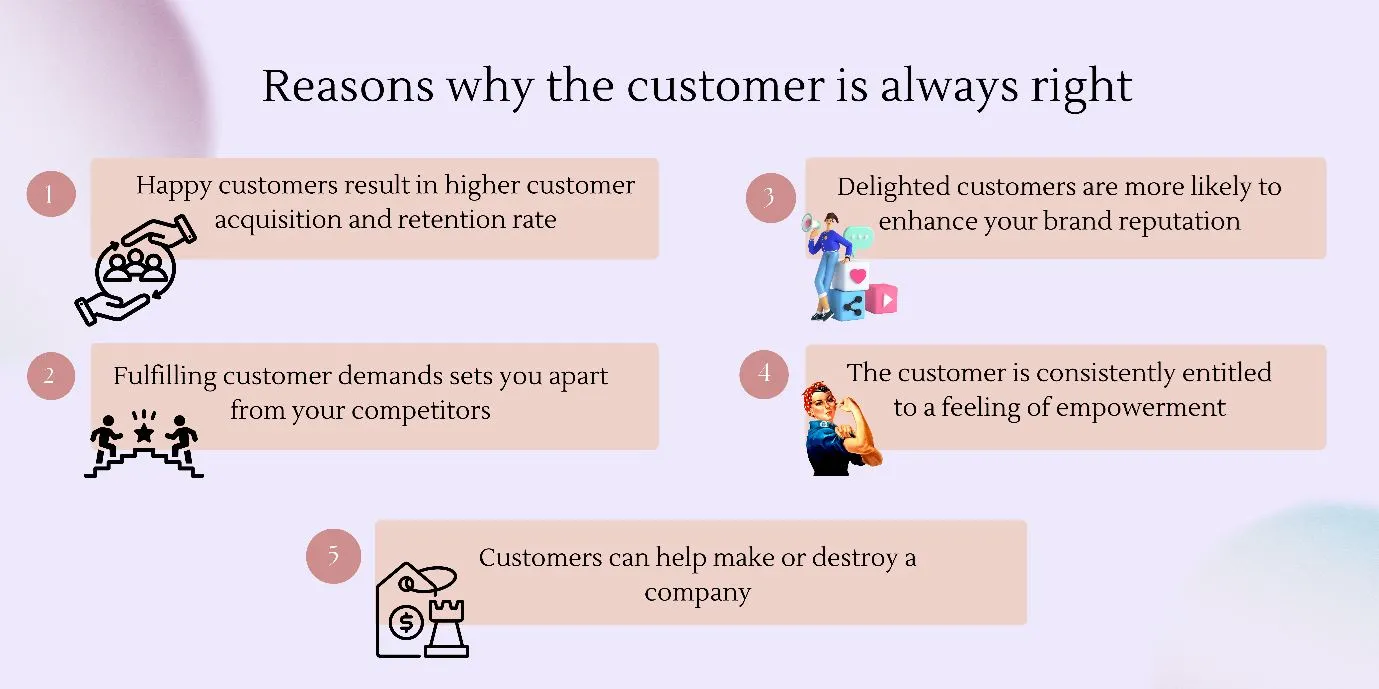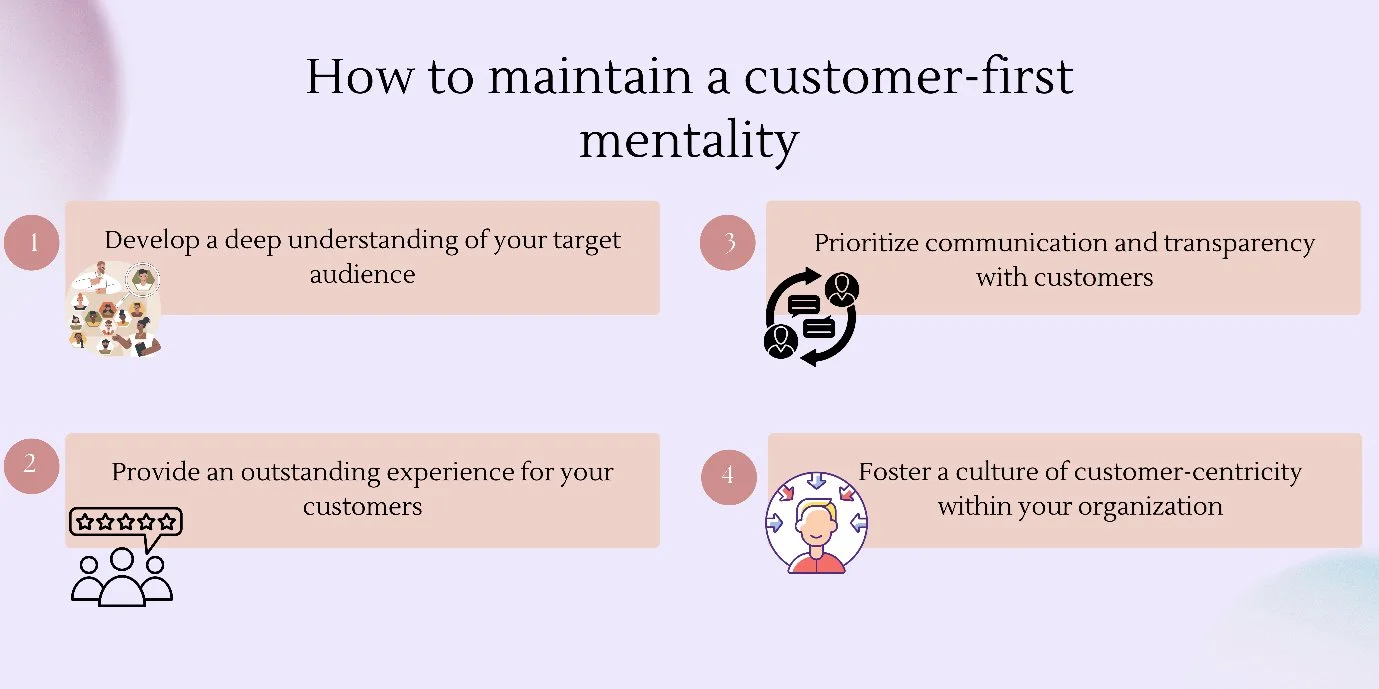The phrase “the customer is always right” has long been a business tune, always highlighting the importance of putting customers first to build loyalty and drive success.
But is it truly the golden rule of business, or is there more to the story?
Businesses have realized that providing a positive customer experience (CX) is essential for growth and success.
This includes acknowledging the phrase when the customer is always right and learning how to handle situations where customers may not be right.
To achieve this, businesses must prioritize customer-centricity in building strong customer relationships.
In this blog, we explore the phrase the customer is always right, its reasons for being true, tips for leading with a customer-centric mindset, and how to handle situations where the customer may need to be corrected.
What does the phrase ‘The customer is always right’ mean?
“The customer is always right” is a business motto that highlights a company’s dedication to delivering excellent customer service to ensure satisfaction and loyalty.
This slogan emphasizes the importance of valuing the customer’s perspective, even if it may only sometimes be accurate.
It acts as a reminder to consistently treat customers with respect and prioritize their happiness and satisfaction, as their presence is crucial for the business’s success.
The origin of “The customer is always right “
The idea that “the customer is always right” was first introduced by Marshall Field when he opened his department store, Marshall Field’s, in Chicago in 1881.
Two other pioneering retailers later adopted this concept: Harry Gordon Selfridge and Swiss hotelier César Ritz.
They were both creative and resourceful businesspeople as they adopted the slogan “Le client n’a jamais tort” (meaning “the customer is never wrong”) as early as the 1890s.
The goal was to:
- Ensure customers feel valued by training support teams always to treat them respectfully and prioritize their needs, regardless of the situation.
- Build customer trust and move away from the prevailing notion of “buyer beware.”
- Emphasize the importance of addressing customer complaints seriously and fairly.
- Enable employees to focus on solving problems and satisfying customers with successful solutions.
Why is the customer always right?
The saying “the customer is always right” shows the importance of putting the needs of the consumer first.
While this phrase is not always strictly accurate, there are several reasons why businesses often adopt the “customer is always right” mindset.

Happy customers result in higher customer acquisition and retention rates
Impressing customers and offering customized customer service may enhance retention and increase sales among existing customers, regardless of how long your firm has been in operation.
According to Small Business Trends by Samson Haileyesus, the likelihood of making a sale to an existing customer is significantly higher, up to 13 times, compared to selling to a new customer.
In fact, customers who are satisfied with your business are more inclined to use your products again and recommend them to others.
Fulfilling customer demands sets you apart from your competitors
Clients have strict requirements and are prepared to go elsewhere if you fail to meet their expectations.
According to 123formbuilder, after experiencing one negative incident, 61% of customers are likely to switch to a competitor
Acknowledging the customer is always right and their perspective, as well as addressing their concerns helps businesses differentiate themselves and stay ahead of the competition.
Delighted customers are more likely to enhance your brand reputation
It’s important to make your customers happy, as they can help promote your brand through positive customer service experiences and recommendations.
This word-of-mouth and online customer service promotion can build trust and a strong reputation for your business.
By prioritizing customer satisfaction, you can turn happy customers into brand advocates.
This belief that the customer is always right is vital for long-term success, as customers are more likely to engage with businesses that they trust and believe prioritize their needs.
The customer is consistently entitled to a feeling of empowerment
Empowering clients to use your products independently is key to building long-lasting relationships.
Knowledge bases and FAQs are two great resources to help clients find answers to their queries and become more self-sufficient.
Providing these resources can lead to greater customer satisfaction, reduce the workload on your support team, and build customer loyalty.
Customers can make or destroy a company
Customers have a significant impact on a business’s success or failure. By employing the phrase “customer is always right”, and listening to their needs and concerns, businesses can build a loyal customer base.
To ensure customer satisfaction, businesses should establish procedures for quickly receiving and responding to feedback promptly.
This can involve:
- Creating online feedback forms
- Setting up customer service communication channels
- Training employees to handle complaints fairly
Tips to maintain a customer-first mentality
Ensuring that your clients receive exceptional service and have a positive experience with your business should be a top priority. Discover more about how to lead with a customer-first approach.

Develop a deep understanding of your target audience
This involves conducting market research, analyzing customer data, and staying up to date on industry trends.
By knowing your customers’ preferences, behaviors, and pain points, you can create your products and services to better meet their needs.
Prioritize communication and transparency with customers
It is vital for businesses to promptly address customer feedback and communicate solutions clearly and understandably to foster trust and loyalty.
Maintaining a customer-centric approach involves being transparent about any concerns and providing straightforward instructions about product usage to minimize discontent and improve satisfaction.
Provide an outstanding experience for your customers
To improve customer support quality, it is important to keep in mind that your customer is always right and provide them with an exceptional experience. This can be achieved by offering various communication channels.

Building a strong connection with customers makes it easier for them to engage with your business and increases the likelihood of their loyalty.
Furthermore, focusing on the customer’s needs helps to create trust and a positive image of your business. Consider using contact management software to enhance communication with customers.
Additionally, provide a customer self-service portal or knowledge base software for customers to find solutions independently.
Foster a culture of customer-centricity within your organization
This means ensuring all employees, from top management to frontline support teams, are aligned to put the customer first.
Even though customers may not always be right, it is still important to understand their point of view by placing their needs above all else.
Additionally, offering training programs, incentives, and performance metrics can all help support this customer-first mentality and ensure that customer satisfaction remains a top priority.
How to stay customer-centric when the customer isn’t right
It is important to maintain a customer-centric approach even when dealing with situations where the customer may not be right, as this is essential for preserving trust and goodwill. Here are some strategies to help with this.
Conduct additional investigation on the issue
Customers frequently believe they have all the information needed to make a judgment or decision.
Before recommending a solution, it’s critical to fully explore the problem if the customer is in error or is missing critical information.
Since you are the subject matter expert in the case, your role extends beyond simply providing solutions; it involves first acknowledging that the customer is always right. This will help in guiding the customer through a process of discovery and enlightenment.
Initiating a thorough investigation of the issue can offer customers more details and valuable insights, increasing trust in your expertise.
It is important to base judgments on information rather than emotions.
Focus on understanding, not being right
Pay close attention to the customer’s sentiment and attempt to empathize with their point of view.
By exploring their concerns further, you can identify the underlying reasons for their behavior.
This may require asking specific questions to better understand their perspective or providing a supportive environment for them to openly communicate their emotions.
Regardless of whether the customer’s perception appears to be mistaken, actively listen to their complaints.
Recognizing their perspective can aid in finding mutual understanding or resolving any misconceptions.
Always remain calm in a professional way
When faced with an upset customer or a mistaken customer, it is important to stay composed regardless of the problem.
The goal is not to prove a point but to listen to the customer and address the issue efficiently. Try to refrain from reacting emotionally.
In a situation where tensions are high, it may be beneficial to pause and carefully consider the tone of your communication. This can prevent you from sending a message that could worsen the situation.
Provide alternative suggestions
In instances where the customer’s specific request cannot be met or if there is a misunderstanding regarding a particular policy or product feature, it is advisable to propose alternative solutions that cater to their needs to the best of your ability.
By doing so, you demonstrate your commitment to achieving a mutually satisfactory outcome. Rather than simply pointing out mistakes, offer constructive suggestions that guide the customer toward a more favourable resolution.
This approach not only showcases your proficiency as a customer service representative but also underscores your expertise in the relevant field, resulting in a positive outcome for all parties involved.
Consider the use of the phrase “the customer is always right” to make an improvement
View these customer concerns as a chance to enhance your customer experience strategies. While “the customer is always right” might not be ideal, focus on building a positive relationship with the customer in the long run.
Unhappy customers, regardless of fault, possess valuable insights and feedback that can contribute to the growth of your business.
Leveraging this customer feedback loop can lead your business to success and set it apart from competitors.
Embrace the phrase “the customer is always right” in business
It has been over 100 years since the phrase “the customer is always right” emerged and became well-known as a reminder to treat consumers with respect and compassion.
As experts in customer experience, the objective of putting the needs of your customers first never changes, even with technological breakthroughs and global shifts.
You may set your company apart from the competition with the manner your agents deal with consumers.
Because consumers can easily share their experiences on various channels, it is even more important for businesses to interact and treat their customers well.
Schedule a live demo and enhance your support team’s customer service abilities by integrating BoldDesk customer service software into your organization.
Feel free to start a 15-day free trial to explore its many features. If you have any questions about its features, contact us through the BoldDesk support team.
Feel free to share your thoughts and suggestions in the comments section below.
Related articles


















 Email Ticketing System
Email Ticketing System Shared Inbox Software
Shared Inbox Software Multi Brand Help Desk
Multi Brand Help Desk Internal Help Desk Software
Internal Help Desk Software Trouble Ticketing Software
Trouble Ticketing Software Mobile Help Desk
Mobile Help Desk 


















